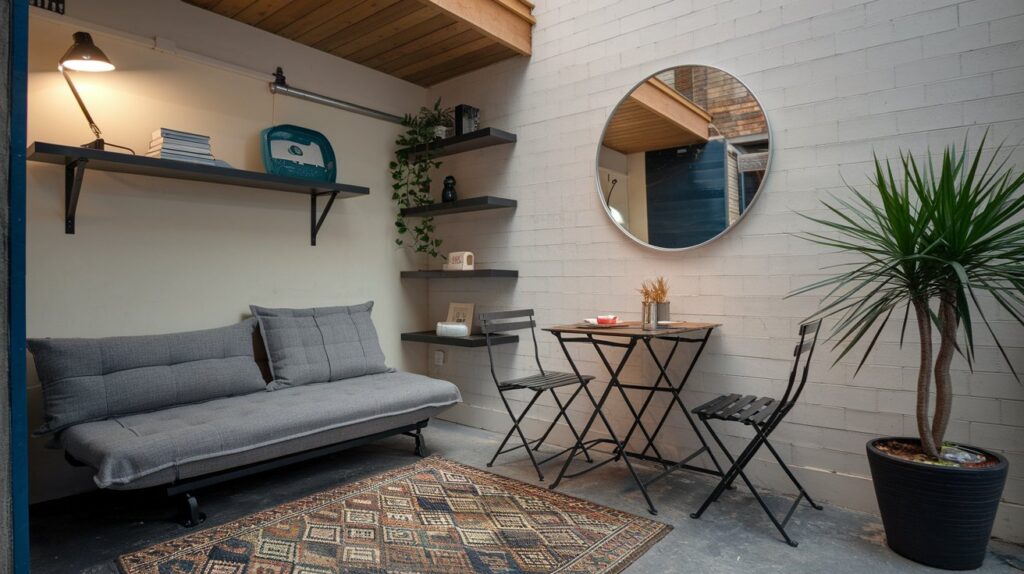In the heart of bustling cities, where space is limited but inspiration is abundant, designing small homes and apartments is both an art and a necessity. Urban dwellers face unique challenges-rising rents, limited square footage, and the constant tension between functionality and beauty. But these constraints are also a catalyst for creativity.
With intentional design, even the smallest studio or micro-loft can transform into a stylish, serene space that supports your lifestyle and expresses your personality.
Decluttering with Purpose
Decluttering doesn’t mean sacrificing warmth or personality. Instead of aiming for stark minimalism, curate your space with intention, keeping only what adds comfort, meaning, or utility. Think cozy textiles, cherished books, or handcrafted accents.
Smart storage is key in small homes. Incorporate multifunctional pieces like ottomans with hidden compartments, under-bed drawers, and floating shelves. Treat storage as part of your design to maintain both order and style.
Space-Saving Layouts that Work
When walls feel like barriers, consider creating an open-concept layout that allows for greater flexibility and flow. Removing unnecessary partitions or furniture that blocks pathways can help your space feel much larger. Instead of defining rooms with walls, use visual cues like rugs, lighting, and furniture placement to designate zones, such as a work corner, a lounging area, or a mini dining space.
One of the most effective tools in small space design is adaptability. Instead of fixed arrangements, opt for pieces that can evolve with your needs. Nesting tables can tuck away when not in use. A fold-out dining table can host dinner for two or expand when guests arrive. A Murphy bed can free up floor space during the day, turning a bedroom into a living room or office.
Making Style Statements in Small Spaces
A unified aesthetic helps reduce visual chaos and makes small spaces feel curated rather than cramped. Whether you’re drawn to Scandinavian simplicity, Japandi calmness, or industrial charm, stick to one design theme for consistency.
This doesn’t mean being rigid. Layer textures and materials to add interest. For instance, a Scandinavian space might combine pale wood, white walls, and wool textiles. An industrial space may mix exposed brick, matte black metal, and reclaimed wood.
Art, Texture, and Decor without Overcrowding
Small spaces can still hold big style. A gallery wall with smaller-scale art pieces can create a striking focal point. Opt for light frames or frameless prints to keep the wall from feeling too heavy.
Texture is another subtle way to add richness without clutter. Think layered rugs, velvet cushions, linen curtains, or a rattan pendant lamp. These elements draw the eye and add depth, making the space feel thoughtfully designed.
Vertical and Multi-Functional Design Solutions
When you can’t build out, build up. Tall bookcases, vertical cabinets, and wall-mounted shelves free up precious floor space. Hang planters or install a hanging rack in the kitchen for utensils and cookware.
For small plants or herbs, a stylish windowbox planter can sit on your windowsill, offering greenery without taking up counter space. These planters bring the outdoors in, enhance visual appeal, and make excellent use of underutilized surfaces.
Furniture That Works Harder
Look for furniture that does more than one job. A sleek console table might serve as a desk by day and a dining surface by night. A daybed can function as both seating and a guest bed. Even a side table with storage built-in can contribute more than just aesthetic value.
The key is to prioritize flexibility and function in every piece you bring into your space.
Tiny Kitchens and Bathrooms
In a small kitchen, layout is everything. Open shelving can make the room feel more airy, especially when paired with well-styled dishware. Slimline appliances and space-saving tools-like roll-out pantries or under-cabinet lighting-maximise utility without crowding.
Consider collapsible or wall-mounted prep tables. Magnetic strips for knives and racks for hanging mugs or utensils can free up drawer space while adding a decorative element.
Beautiful, Functional Bathrooms
Bathrooms are often the smallest rooms in a home, but they don’t have to be overlooked. Install floating vanities or compact pedestal sinks to open up floor space. Choose mirrored medicine cabinets to add storage and reflect light.
Even in a compact bathroom, small design choices-like consistent tile patterns, vertical towel racks, and a cohesive color palette-can dramatically enhance the sense of space and style.
Making the Most of Balconies and Windows
City living often means limited access to outdoor space, but a balcony or even a wide window ledge can become a peaceful escape. Use foldable furniture to maximize room and create a cozy nook with cushions, string lights, or a weather-resistant rug.
If your windowsill gets enough sunlight, a tabletop windowbox planter adds life to your space while offering a visual extension of your interior. Plant herbs, succulents, or seasonal flowers to create a miniature urban garden with minimal effort.
Conclusion
Small-space living doesn’t have to mean sacrifice. When you approach design with intention-choosing pieces that serve a purpose, support your lifestyle, and bring you joy-you create a space that feels expansive in its possibilities.
Whether you’re outfitting a 400-square-foot apartment or simply seeking to live more mindfully, the principles above offer a pathway to stylish, satisfying urban living. Start with one room, one corner, or even a single windowbox planter, and transform your space with thought, purpose, and personality.

